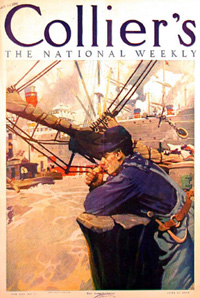 Collier's Weekly (New York, NY, USA)
Collier's Weekly (New York, NY, USA)
- The Crime of Partition (Jun 14, 1919)
- A Clipper Ship I Knew (Oct 27, 1923)

27 June 1908
Collier's was an early exponent of the use of halftones in news reporting, thanks in part to the pioneering work of its photo-correspondent James H. Hare during the 1898 Spanish-American War and the 1905 Russo-Japanese War. The magazine's high rates of pay attracted the cream of writers and illustrators, among them Howard Chandler Christy and Charles Dana Gibson, while hefty prize competitions secured contributions from promising newcomers. Arthur Conan Doyle's 'The Return of Sherlock Holmes' stories were first serialized in Collier's in 1903-1904, as were Henry James's 'The Turn of the Screw' in 1898 and H.G. Wells's Mr Britling Sees It Through in 1916. Other prominent contributors were H. Rider Haggard, Rudyard Kipling, O. Henry, Frank Norris, Edith Wharton, Arnold Bennett, Edgar Wallace, Jack London, Winston Churchill, Anthony Hope, Willa Cather, and P.G. Wodehouse. Maritime and naval matters, including submarine warfare, also featured regularly, ranging from Conan Doyle's 'Danger!' to the winner of the 1914 Fiction Competition, James B. Connolly's 'The Trawler'. Between 1913 and 1949, the magazine published Sax Rohmer's famous Fu Manchu series.
Conrad's first contribution to Collier's, 'The Crime of Partition', was intended to mobilize support for Polish independence at the upcoming Versailles Peace Conference. 'It appeared here in the Fortnightly Review and was much more noticed generally than anything of the sort I have ever written,' Conrad told John Quinn in September 1919, adding: 'I am also very satisfied with its publication in Collier's Weekly' (CL 6:496).
Sources
Collier's Weekly. Galactic Central Magazine Archive. To view gallery of cover images, click here.
Davies, Laurence, et al., ed. The Collected Letters of Joseph Conrad. Cambridge: Cambridge University Press, 1983-2007. 9 vols.
Knapp, Lawrence. Sax Rohmer's Newspaper Appearances.
Mott, Frank Luther. American Journalism: A History of Newspapers in the United States Through 260 Years: 1690 to 1950. Revised edition. New York: Macmillan, 1956.
Mott, Frank Luther. A History of American Magazines, Volume IV: 1885-1905. Cambridge, Mass.: Harvard University Press, 1957. 453-79.
Russell, Richard and Elaine Gross. Vintage Magazines Price Guide. Iola: K.P. Books, 2005. 152-3.
Ward, Michael. MagazineArt.org. Collier's Magazine.